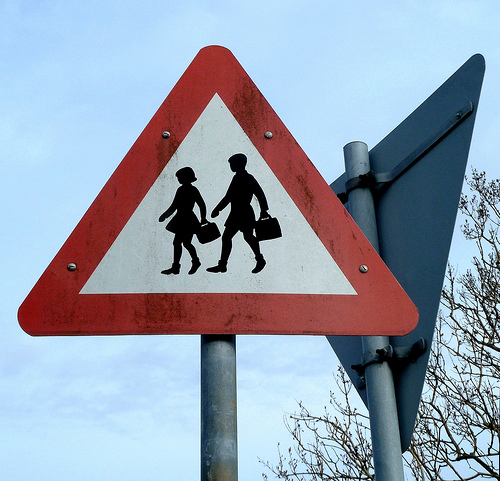Does traffic safety education make kid pedestrians any safer?
It’s not news that traffic accidents hurt and kill children disproportionately. But what steps can be taken to help keep kids safe? “Can child-pedestrians’ hazard perception skills be enhanced,” a recently released study from researchers Anat Meir, Tal Oron-Gilad and Yisrael Parmet, aims to pinpoint how children can better understand the dangers posed by traffic by understanding traffic safety scenarios from different perspectives.

Kids’ ability to cross streets safely isn’t just an age thing – they benefit from instruction. Image from Flickr’s Jens Rost.
While many experts agree that kids under age 9-10 should not cross the street by themselves (one study has shown, for example, that kids aged 7 to 13 lack the same ability to identify danger while crossing as experienced adults) in motorized countries, kids under the age of 9 do cross streets solo, especially on their way to and from school. The researchers’ goal, then, was to minimize the danger through education rather than encourage kids to walk with companions. For their study, a group of children observed a number of typical traffic scenes and were asked to note the differences between each one, from both a pedestrian’s perspective and a higher perspective.
The study aimed to see if children could, through the learning experience, improve their hazard perception skills. For the study, 24 seven- to nine-year-olds observed 40 minutes’ worth of typical traffic situations. They were asked to notice the differences between the varying scenes from different angles: a pedestrian’s point of view, plus a higher perspective angle. The kids were then asked to make street crossing decisions.
In a nutshell, the study discovered that “child pedestrians are responsive to training and actively detecting materialized hazards may enrich child-pedestrians’ ability to cross roads.” What does that mean, exactly? The kids who were exposed to more potential hazards performed better when asked to perform a street crossing task than the kids in the control group, who didn’t undergo the 40-minute training. Kids aged 7 to 9 made the choice to cross simulated roads “significantly less in situations involving limited field of view partially obscured by parked vehicles.”
There was a marked difference between the trained kids and the non-trained kids. In fact, the researchers note, “trainees’ likelihood to decide to cross was significantly higher in situations depicting unrestricted field of view and in situations depicting field of view partially obscured by the road’s curvature than in situations depicting field of view partially obscured by parked vehicles, [while] the control group members’ likelihood to decide to cross was similar in each of the field of view conditions.” In other words, being exposed to different perspectives may have granted the kids the ability to infer danger where the control-group kids saw none.
The takeaway: Kids’ ability to make good traffic safety decisions about when to cross a street may not be entirely related to age or maturity, but may, in fact, be taught and improved upon. Given that certain studies show that parents don’t spend much time educating their children safe pedestrian skills (and, also that parents tend to overestimate their children’s ability to cross safely) this study is particularly notable: with greater education, the researchers point out, safety can be improved. Learn more about the study and its implications by checking out the full report online.
Related Posts
Category: Transportation

















